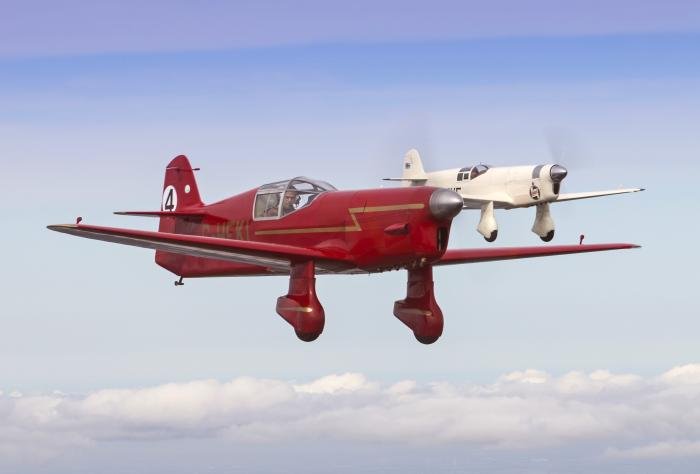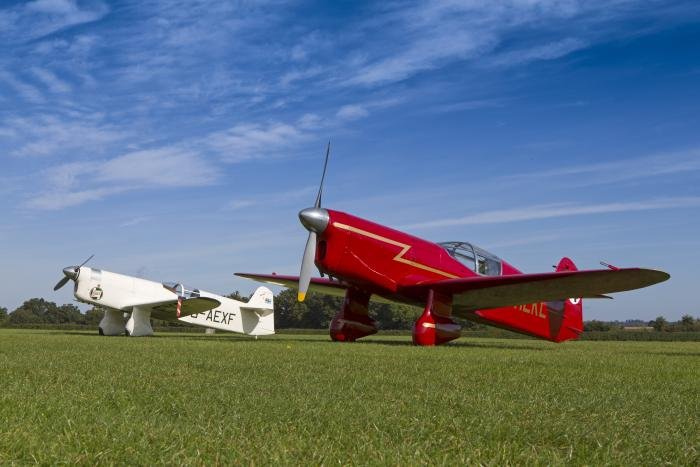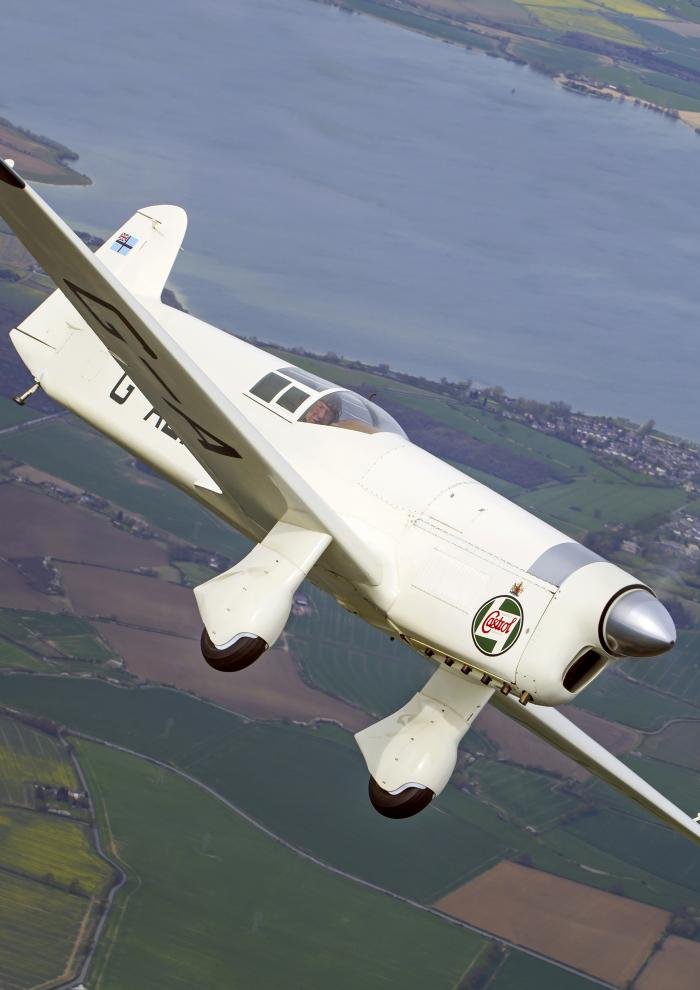MIGHTY MEWS
The Shuttleworth Collection’s Percival Mew Gull G-AEXF and David Beale’s replica G-HEKL make for a splendid pair — and an interesting comparison
By BEN DUNNELL
Photography by DARREN HARBAR
With two Percival Mew Gulls now gracing British skies, it was only natural to bring them together. Thanks to the Shuttleworth Collection and David Beale, several times their respective machines have displayed together over Old Warden, paying tribute to the exploits of these exceptional, no-compromises racers.
Yet the formation sortie mounted for this feature was interesting in other ways, too. One would expect Shuttleworth’s G-AEXF, in the last of its many restorations returned to Alex Henshaw’s 1939 Cape record configuration, to be the faster of the pair. It depicts the Mew Gull at the peak of its pre-war powers, after all. David Beale’s replica G-HEKL, meanwhile, is a precise re-creation of the long-lost G-AEKL as it was in 1937. Even so, the ‘new Mew’ outpaces ’XF. “We’re not really sure why”, says Shuttleworth chief pilot Roger ‘Dodge’ Bailey — “whether it’s an engine or a drag issue. When we had them up together we did a bit of a ‘drag race’, and ’KL will leave ’XF behind. It’s not a startling difference, but it will walk away.”

Just one of the interesting traits one discovers in comparing the two Mew Gulls, aided by the men who fly them. Since late 2013, G-AEXF has been part of the Shuttleworth Collection, and one can think of few finer additions to its line-up. That the aircraft survives is down to the efforts of many owners and restorers keen not to see this most historic air racer laid low. Behind David Beale’s creation of G-HEKL is another story of remarkable dedication, one that started eight years ago. The founder of Cambridgeshire-based automation consultancy Innomech, David saw advertised for sale “some bits… basically a set of drawings, an engine and a part-complete fuselage that needed to be rebuilt”. Thus began little less than a new phase of his life.

Derby-based restorer and replica builder Ken Fern had started the project for a friend in the USA. He was aided by drawings made of G-AEXF when Tom Storey rebuilt it after one of its numerous mishaps. During 2007, the owner decided to sell, and David Beale stepped in. “The big problem”, says David, “was whether it was a project that could be constructed and registered under the LAA [Light Aircraft Association]. I then had to negotiate with [LAA chief engineer] Francis Donaldson”. He liked what he saw, and approval was forthcoming.
Helping ensure accuracy was the LAA’s proviso that David should adhere absolutely to the original, otherwise all the stress calculations would have to be re-done. However, he discovered, “there were detail errors on the drawings when compared to original information unearthed during the project”. These were an inevitable consequence of the number of times G-AEXF had already been rebuilt and re-configured, involving a good deal of reverse-engineering to take it back to its 1937 configuration, before Tom Storey got his hands on it.

It goes without saying that exact period materials and components were used throughout. For the project to come with an authentic engine was, of course, a huge bonus. Even better, the 1936 unit’s serial number was between those of the powerplants used in the production Mew Gulls. “That was a Ken Fern find. It’s a Gipsy Queen 1, which is a rare beast, and it had never been used. It was overhauled and bench-run [for just six hours] by Hants and Sussex, but it had never been in an airframe. It was bought from the RAF, and someone decided they wanted to use it in a Rapide. They paid for it to be overhauled and then discovered it was not suitable for a Rapide, so it stayed in his garage. I think the guy died, and it went through various hands.
“Sadly, it had been badly stored — they had used wax preservative on the cylinders, and someone had turned the prop. On the four ports that were open, the cylinders had corroded, and they were scrapped. I had to find four new cylinders for it”. Easier said than done, that, “especially as I wanted them still within standard size. That was a major headache and took quite a lot of sorting-out. I think I went through about 16 cylinders before I found four good ones.”

David alone spent about 10,000 hours on the project, involving many long evenings in his home workshop, but he did have some assistance. “Ken Fern helped sort the fuselage out. I measured it and found the fuselage was too tall — Ken told me that it had actually been built too tall, because the American was a tall guy, but I wanted it as it was originally designed. I arranged for Ken to do some finishing-off woodwork for me.
“The wings were done by Roger Burrows over at Watton. I asked him initially to build the spars, because, as Tom Storey found, they’re horribly complicated. There’s not a parallel surface on the things, and they’re a composite of ash, spruce and ply. It really needed the proper woodworking tools and set-up to do that. When he’d done those, I asked him if we could build the wing in his workshop. We set it up there, and he did quite a lot of the precision work while I was the ‘gopher’, holding things, sticking things and double-checking for him. The pair of us skinned it, and it came over to me for finishing.

“The wing was finished off in a tent inside the chicken shed that’s my hangar at Witchford. Working through the winter was not fun! The fuselage and tailplane were done in my workshop at home, once Ken had finished the basic woodwork. With the wing, I had to make the undercarriage and the fuel tanks. Obviously, I got the fuel tanks made by a CAA-approved aluminium welder. They had to be fitted before the wing was assembled, so a lot of that was done early on. So were the complex undercarriage mounts, involving many workshop hours machining thin-wall tube of the correct dimensions from solid bar as no suitable tube was available. Also fashioned from aluminium are the cowlings and spats, requiring me to learn the black art of using the English wheel.”
David was keen to ensure that the cockpit was as right as possible, “with only a few minor compromises to modern safety requirements — the vintage Pyrene brass fire extinguisher contains a modern extinguisher”. His search for period items goes on, and this August he was donated two more: “the correct-sized manifold gauge, which needs to be rebuilt, and the correct oil pressure gauge.”
During 2013, completion came into sight. “I started it as my retirement project”, says David, “my means of getting myself out of work”. Gradually he started reducing the number of days he spent in the office, to the point where his colleagues could call on him if necessary. The airframe was finished with 32 coats of period satin dope, each hand-flatted to give the correct smooth appearance. Final assembly was carried out at Witchford, where the local farmer’s teleporter was used to help install the engine. “That replaced the cardboard engine I’d used to do all the cowlings”, David recalls. “Luckily, it fitted.”
Mating the wings and fuselage also caused some anxious moments. “There were 56 quarter-inch bolt-holes to be drilled, and they all had to be perfectly aligned to go right through the spars, which are about 6in thick, lining up brackets so that the hole went through the metal bracket, the spar, and out through the hole and the metal bracket on the other side. It took a lot of nerve!”
It all worked, and test pilot Charlie Huke took G-HEKL into the air for the first time on 20 August 2013. He flew out of Witchford, but landed at RAF Henlow, where the remainder of the flight-test programme was carried out successfully. Now the Mew Gull is based at Fenland, as David’s strip at Witchford, 600m long with trees at one end, is too limiting.

“Since completion the aircraft has performed exactly as per the certificate of airworthiness test flight reports from 1936 and ’38”, David reports. “It is fast, and could, if caution was thrown to the wind, achieve the average race speed of 233mph achieved by the production airframe in the 1937 King’s Cup. We’ve never got the ultra-high speeds because people were tuning the engines. It cruises comfortably at 200mph using the de Havilland-recommended engine settings, easily achieves a VNE [never exceed speed] of 265mph and a climb rate in excess of 2,000ft per minute.”
This brings us back to the slightly slower G-AEXF. Although it had been based at Old Warden in Desmond Penrose’s ownership, ‘Dodge’ Bailey did not fly the aircraft until its acquisition by Shuttleworth from previous owner Robert Fleming, who based it with the Real Aeroplane Company at Breighton. “When we were purchasing it”, says ‘Dodge’, “I went up to Breighton and spoke to ‘Taff’ Smith, who was the current pilot. I got a very good briefing on it from ‘Taff’, which I recorded and then wrote up. That set me up quite well. I also watched his landing when he delivered it to Old Warden, and videoed that.”
A highly experienced test pilot with a vast bank of knowledge when it comes to vintage aircraft, ‘Dodge’ offers a typically authoritative view of flying the Mew Gull. “The first impression you get is when you take off, which is perhaps unfortunate… it’s an aeroplane that’s quite easy to over-control, and if you look at all the reports, going right back to 1935, they all hint at that tendency. In terms of axes, you can easily over-control in pitch, and to some extent in yaw, particularly when the tail comes up.
“Both of those challenges are made more difficult to sort out because of the restricted field of view, so it takes you longer to spot that the aeroplane is doing something you haven’t asked it to do. You have to keep it straight using peripheral vision, and select a suitable pitch attitude, but unlike most aeroplanes just selecting the right pitch attitude isn’t enough — it won’t stay there. The slightest bump, change of airspeed or whatever will cause the nose to pitch. Although all the write-ups complain about the aeroplane being too sensitive […] that’s the symptom. The underlying reason for it is that with full power the aeroplane is neutrally stable at best, maybe unstable in pitch. In addition, taking off with a significant right crosswind component must be considered carefully as the weathercock stability will join forces with the asymmetric blade effect, torque and precession effects, and there is only a diddy rudder to counter them.
“The stall is described variously as [being] completely benign to a sudden wing drop. Taking the worst-case scenario of a wing drop-prone aeroplane, as it gets airborne and starts to skip the wheels and bounce off little bumps, the idea is to let it do that and not try and haul it off the ground, risking a wing drop-type stall. Take-offs are made with one or two notches of flap. The flaps are tiny, and it’s a mystery to me that they do anything at all, but they do seem to help.
“Once airborne, the aeroplane is quite nice to control. It’s sensitive in pitch because there’s virtually no longitudinal stability. The roll axis is fine — although the fin is quite small, the aeroplane has got lots of keel area in the rear fuselage, which makes it very stable directionally. Having said that, it is quite easy to have the rudder in the wrong place, so that the aeroplane is out of balance. That does require a bit of attention, particularly at high power.
“Away from the ground with the airspeed building up, it’s a bit like the Comet in many ways. That is, it’s quite nice to fly about, though the field of view straight ahead is poor. And to display it’s pretty easy. Put the nose down and it goes pretty fast. You can manoeuvre it around in wingovers quite comfortably… and it gives you lots of confidence.
“Indeed, I found the aircraft a great ‘lead-in’ trainer for the Comet. It has virtually the same powerplant, the ‘up and away’ handling is similar, as is the stall, and the restricted field of view we enjoy from ’XF pretty much necessitates a curved approach like the Comet. One can also practice the essential Comet ‘touch-down and pin’ technique as a training exercise.”
David Beale can testify to the Mew Gull’s handling qualities. “In the air, it’s just a delight”, he comments. “The sole exception is the view out. “You can’t see much ahead of you. If I sit up with my head touching the canopy, I can just see the horizon.”

Landings offer their own challenge. “I was told by ‘Taff’ Smith just to do three-point landings in the aeroplane”, says ‘Dodge’. “His rationale was that, if you’re doing anything else, you’re too fast, and the brakes aren’t very good. We come in at 75kt in ’XF, and the stall is about 10kt below that. When you close the throttle it does float for a long time, probably because the aeroplane is so clean. Although it is perfectly possible to wheel it on at this point, following ‘Taff’s’ advice, we generally wait for it to land on three points. Sometimes you get a slightly tailskid-first landing, but that just de-rotates the aeroplane onto the mainwheels and then it rolls along straight. It’s very easy to keep straight on landing — it’s not an aeroplane that’s eager to ground-loop, which is one of the better features.”
In contrast to Shuttleworth’s technique for landing ’XF, both David and Charlie Huke prefer to perform a wheeler, as opposed to three-point, landing. They both experienced three-point landings where the aircraft hit a bump and entered wing-drop territory, and it minimises annoying airfield owners with a skid acting like a plough, as ’KL has a wider skid foot. “It also is less vicious to the fragile skid”, says David, “and the idle on ’KL, for some reason on the earlier carbs, cannot be reduced as low as on ’XF”. This somewhat restricts the range of airfields from which ’KL can safely operate, a 600-yard runway being the minimum.
Two similar-looking aircraft, then, but each with their own individual characteristics and foibles. Such would, of course, have been the case when comparing the 1930s Mew Gulls. What a privilege to see these two aeroplanes together, and what a testament to those who have made it possible.

